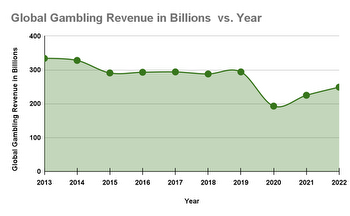Deceleration of Gaming Revenue Growth in the USA

The gambling industry has long been a significant economic driver in the United States, captivating millions with the allure of chance and the promise of lucrative rewards. From the bright lights of Las Vegas to tribal casinos and state lotteries scattered across the nation, gambling has woven itself into the fabric of American culture.
Gaming revenue has been on an upward trajectory for decades, bolstering state budgets, creating jobs, and contributing to local economies. However, in recent times, the gambling landscape in the USA has experienced a notable shift.
The once-steady growth in gaming revenue now faces headwinds, and signs of deceleration have become apparent. Today, we delve into the current state of gambling income in the USA, exploring the factors that have contributed to its historical growth and the emerging trends that signal a slowdown.
Historical Perspective on Gaming Revenue Growth
Gambling has a deep-rooted history in the United States, with its origins dating back to the colonial era. Over the centuries, various forms of gambling emerged, ranging from informal betting activities to organised lotteries and horse racing.
Key Milestones in the History of Gambling in the USA
A few significant milestones have played a crucial role in shaping the gambling landscape and fueling revenue growth:
- Lotteries and Charity Gaming: In the early 17th century, lotteries were established as a means to fund public works, including infrastructure and educational initiatives. Notably, the first American lottery was authorised in 1612 to finance the Jamestown Colony. Throughout the 18th and 19th centuries, lotteries remained prevalent, with proceeds often allocated for charitable purposes.
- The Wild West and Frontier Casinos: As the nation expanded westward, gambling establishments flourished in mining towns and along the frontier. Saloons housed games of chance, poker tables, and slot machines, contributing to local economies during the late 19th and early 20th centuries.
- The Las Vegas Boom: The construction of the Hoover Dam in the 1930s brought an influx of workers to Las Vegas, setting the stage for the city’s transformation into a gambling mecca. The legalisation of gambling in Nevada in 1931 marked a turning point, leading to the establishment of lavish casinos and hotels that attracted tourists from across the country.
- The Birth of Tribal Casinos: The 1988 Indian Gaming Regulatory Act provided Native American tribes with the opportunity to operate casinos on tribal lands. Tribal gaming rapidly expanded, creating a new revenue stream for indigenous communities and spurring economic development in previously disadvantaged areas.
Factors That Contributed to the Growth of Gaming Revenue
Several factors have driven the growth of gaming revenue in the USA over the years:
- Entertainment and Tourism: Casinos and gambling destinations have been major attractions for domestic and international tourists. The allure of entertainment, dining, and other amenities, along with the thrill of gambling, has drawn visitors, bolstering local economies.
- State Lotteries and Government Budgets: State lotteries, which began to gain popularity in the 1960s and 1970s, have been instrumental in funding public programs, including education and infrastructure. Lottery ticket sales have been a significant contributor to gaming revenue.
- Innovation in Casino Games: The introduction of new casino games and slot machines, often incorporating cutting-edge technology, has enhanced the gaming experience and attracted a broader audience.
- Changing Attitudes and Legalization: Over time, attitudes toward gambling have evolved, leading to the legalisation of various forms of gambling in many states. This expansion has opened up new markets and revenue streams.
Factors Impacting Gaming Revenue Growth
The deceleration of gaming revenue growth in the United States is influenced by a combination of factors that have both short-term and long-term implications for the industry. Understanding these factors is essential for industry stakeholders and policymakers to make informed decisions and identify strategies to navigate the evolving landscape.
Competition From Neighboring States
One significant factor affecting gaming revenue growth is the intensifying competition from neighbouring states. As more states legalise gambling in various forms, regional casinos face challenges in attracting customers from areas with easier access to gambling options. This competition has led to revenue cannibalisation, impacting the growth rates of individual casinos and gambling establishments.
The Rise of Online Gambling Platforms
The advent of online gambling has disrupted the traditional brick-and-mortar casino model. Online casinos, sports betting platforms, poker rooms, and other interactive gaming sites have gained popularity, providing convenience and accessibility to consumers, including those looking for a fast withdrawal casino experience.
On top of that, nowadays, casino review sites are offering in-depth reviews for these iGaming platforms, helping users find the best fast withdrawal casino and free spins options you can check at https://www.slotozilla.com/uk/free-spins/50-free-spins-no-deposit. In that light, gamblers have it easy just to sit back and relax from the comfort of their home.
Changing Consumer Preferences and Behavior
Demographic shifts and changing consumer preferences have played a significant role in the deceleration of gaming revenue growth. Younger generations exhibit different preferences when it comes to gambling.
They tend to favour skill-based games, esports betting, and interactive experiences, which may diverge from traditional casino offerings. As the gambling industry caters to new consumer demands, it must adapt to remain relevant and attract a wider audience.
Regulatory Environment
The regulatory environment surrounding gambling varies widely from state to state. Some states have embraced a more permissive approach, allowing for a wide range of gambling activities, while others maintain more restrictive policies.
Technological Advancements and Innovation
Technological advancements have revolutionised the gambling industry, introducing new gaming experiences and platforms. From virtual reality (VR) casinos to mobile betting apps, innovations have reshaped the way people engage with gambling.
State-By-State Analysis
The gambling landscape in the United States is not uniform, as each state has its unique regulatory framework and gambling offerings. As a result, the performance of the gambling industry varies significantly from state to state. Let’s explore the gaming revenue trends in some major states known for gambling:
Gaming Revenue Comparison: Major States
The table below showcases gaming revenue figures for the latest available data in select major gambling states, highlighting variations in revenue growth:
Analysis of State-Specific Trends
Here are some pro-gambling trends that these states usually support.
- Nevada: Known as the gambling capital of the USA, Nevada’s gaming revenue heavily relies on Las Vegas, which attracts tourists and visitors from around the world. Despite facing competition from other states, Nevada continues to maintain a strong gaming industry due to its iconic appeal and diverse offerings.
- New Jersey: The state’s gaming revenue has experienced significant growth since the legalisation of online gambling and sports betting. The online gaming market has flourished, providing a steady stream of revenue for the state. With its numerous casinos, Atlantic City remains a major gambling destination on the East Coast.
- Pennsylvania: Pennsylvania’s gaming revenue has shown steady growth due to the expansion of both land-based and online gambling options. The state’s large population and proximity to major cities contribute to its strong performance. Philadelphia and Pittsburgh have emerged as key gambling hubs.
Regional Disparities and Factors Impacting Revenue
The state-by-state analysis underscores the importance of regional disparities in gaming revenue growth. Factors such as population size, geographic location, regulatory policies, and consumer preferences significantly impact revenue trends. States with favourable regulatory environments and diversified gambling options tend to experience more robust growth.
Final Words
In conclusion, once a steady driver of economic growth, the gambling industry in the United States is experiencing a deceleration in gaming revenue. This trend can be attributed to a combination of factors, including increased competition from neighbouring states, the rise of online gambling platforms, changing consumer preferences, the impact of the COVID-19 pandemic, and varying state-level regulations.
The industry must adapt to meet the evolving demands of a new generation of consumers seeking innovative and interactive gaming experiences. By embracing change, implementing effective strategies, and fostering a sustainable and socially responsible approach, the gambling industry in the USA can pave the way for a revitalised future and continued success in the years to come.


































